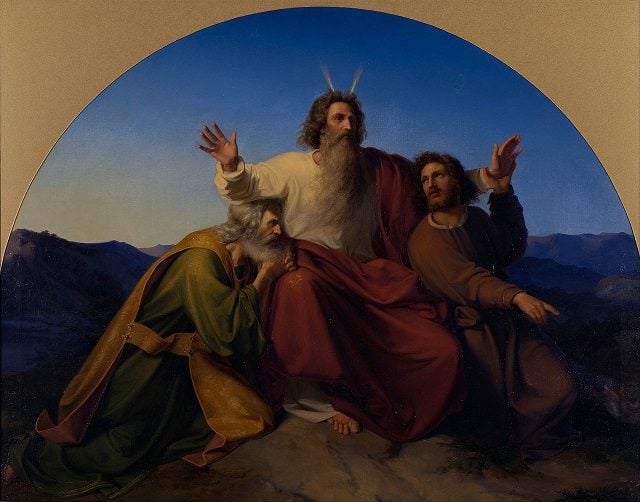Pearce’s Potshots #35, in Which Our Brave Hero Classifies Moses as “a Mythological Figure” and I Reply!

Anti-theist atheist Jonathan M. S. Pearce, with whom I have had many dialogues, lately denied the historical existence of Moses altogether:
[I]t’s worth noting that the Louvre museum in Paris has a stele concerning Sargon’s victories and reign dating to 2300 BCE. We have actual contemporaneous evidence of the existence of this man from 1000 years before Moses was supposed to have existed. This is a historical figure, after all. Moses isn’t. (6-12-21)
Moses is a mythological figure. (6-13-21)
This shouldn’t surprise anyone, since he also just stated that he has a “confidence of about two-thirds that a real Jesus existed under all the mythological overlay as opposed to one-third confidence in a completely mythological Jesus”, and that “all we can know about a historical Jesus is that he lived in Nazareth, was an itinerant preacher, and was executed in Jerusalem. Everything else is myth. Thus the Jesus of the New Testament is effectively mythological anyway . . . the vast majority of the Gospels are completely mythological.”
In any event (like a good cynical, apathetic postmodernist agnostic), Pearce doesn’t “really care either way.” It’s ultra-fashionable these days among atheists, to deny Jesus’ existence altogether (“mythicism”). Pearce is clearly on that road, and it likely won’t be long before he gives up every shred of historicity of the incarnate God. I’ve long considered this position intellectual suicide.
I don’t intend to do a full survey of this question of the historical Moses. That’s the task of historians and archaeologists. I’ve written very little about the Exodus (where evidence is much more scanty and controversial) and have concentrated on archaeological evidence from Joshua’s conquest (c. 1250 BC) and afterwards (as I will in this paper). I will only present a few pieces of indirect / deductive evidence that I consider “strong.”
There are several good books on archaeology and the Exodus, most written (or partially written) from a more traditional, “pro-biblical” perspective by qualified scholars:
Exploring Exodus: The Origins of Biblical Israel (Nahum M. Sarna [Professor of Biblical Studies at Brandeis University and editor and translator of the Jewish Publication Society’s translation of the Bible] Schocken, 1996, 277p)
Israel in Egypt: The Evidence for the Authenticity of the Exodus Tradition (James K. Hoffmeier [Professor of Bible Studies and Archaeology], Oxford University Press; Revised edition: 1999, 280p)
Israel’s Exodus in Transdisciplinary Perspective: Text, Archaeology, Culture, and Geoscience (Quantitative Methods in the Humanities and Social Sciences) [44 scholars] (Springer, 2015 edition, 611p)
“Did I Not Bring Israel Out of Egypt?”: Biblical, Archaeological, and Egyptological Perspectives on the Exodus Narratives (edited by by 2016, 352p)
The Exodus (2017, 304p)
My methodology in this paper will be one of “deduction based on physical evidence.” If the Bible is shown to be accurate again and again in historical detail, by archaeology, historiography, and physical science, then we can at least provisionally trust it for details that — as of yet — lack absolute or “concrete” confirmation from archaeology. The two pieces of evidence I shall be briefly examining, provide corroborating tangible physical evidence from close to the time that Moses is believed to have lived.
Referring to his remarkable excavations on Mt. Ebal (connected with Joshua’s conquest of Canaan), which we will shortly examine, eminent Israeli archaeologist Dr. Adam Zertal noted in 2006: “If this corroborates exactly what is written in that very old part of the Bible, it means that probably other parts are historically correct. The impact is tremendous.”
I agree! So let’s start with his work there, which I referred to in my 2014 book about my visit to Israel in that year: Footsteps that Echo Forever: My Holy Land Pilgrimage, and in an article from that chapter, now on my blog: Joshua’s Altar on Mt. Ebal: Findings of Recent Archaeology. I will cite it at length (I won’t bother indenting everything). For background, read the relevant biblical texts that are cited in their entirety in the beginning of my article.
1) Joshua’s Altar on Mt. Ebal (dated 1220-1000 BC)
We were immediately able to date these sherds to the early part of the period archaeologists call Iron Age 1 (1220-1000 B.C.), the period during which the Israelites entered Canaan and settled there. Iron Age 1 also includes the period of the Judges.
[T]he bones, which were found in such large quantities in the filling, were sent for analysis to the zoology department of the Hebrew University in Jerusalem. The bones proved to be from young male bulls, sheep, goats and fallow deer. . . . The first chapter of Leviticus describes the animals that may be offered as sacrifices. A burnt offering must be a male without blemish (Leviticus 1:3). It may be a bull (Leviticus 1:5) or a sheep or a goat (Leviticus 1:10). The close match of the bones we found in the fill with this description in Leviticus 1 was a strong hint as to the nature of the structure we were excavating. . . .*942 bones were examined, representing 50-100 specimens. These were attributed to four kinds of animals: goats, sheep, cattle, and fallow deer [Mosaic Law allowed the eating of deer: Deuteronomy 14:4-5]. The latter is a light-spotted animal which inhabited the woodlands of our country in antiquity. Examination of the sex and age of the animals revealed that all those that could be diagnosed were young males, approximately one year old. This correlates remarkably with the laws of sacrifice in the book of Leviticus [1:1-3] . . .*A great part of the bones, as we mentioned, had been burned over a fire and were cut near the joints. Being scorched in this way attests that the flesh was not intended for eating but was burned over an open fire (i.e. not in an oven). Thus the high correlation with the biblical laws of sacrifice, together with the great architectural resemblance to Israelite altars, confirmed the view that we were dealing with a cultic site and altar from the beginning of the Israelite settlement.
Recent extensive archaeological surveys of the central hill country, however, reveal clearly the process of Israelite settlement as a major settlement movement of the era (1250-1100 b.c.e.). Hundreds of newly-founded, small settlements were established within a short period throughout the hilly allotments of the tribes of Manasseh, Ephraim and Benjamin. . . .*The varieties of animal bones discovered are evidence that the laws of sacrifice were followed from the very beginnings of the Israelite religion. Despite the presence of wild boars in the region, not a single bone of this animal, not fit for sacrifice, was found on Mt. ‘Ebal.
In the Late Bronze Age Hazor [see Joshua 11:10-13] was the largest city and the most dominant city-state in Canaan. This has been confirmed both by the archaeology and by several ancient historical sources. . . .*In [Yigael] Yadin’s excavations [he was professor of archaeology at Hebrew University of Jerusalem] the areas where Late Bronze II – Iron Age I excavations took place are Areas A, B, BA, all of them in the Upper City. A Late Bronze II level was also found in Areas H and 210/A1 in the Lower City. The large Late Bronze Age city (Strata XV-XIII) was totally destroyed at the end of the period, probably in the second third of the 13th century. . . . [within about 17 years of Moses’ death]*The question of who destroyed Canaanite Hazor and who were the inhabitants of the first Iron Age town is controversial. Following Yadin’s project it seemed clear that both were Israelites. [Yohanan] Aharoni [chairman of the Department of Near East Studies at Tel Aviv University] claimed, the same as Yadin, that, “the total destruction of Hazor and the attempted Israelite settlement conforms well to the biblical tradition that the city was demolished by the Israelites”. . . .*According to [Amnon] Ben -Tor [professor of archaeology at Hebrew University of Jerusalem], the most probable possibility is the Israelites.*Rafael Frankel, who recently carried out surveys in Upper Galilee [see the book], came to the same conclusion. He maintains that “in the case of the conquest of Hazor too, the archaeological finds ostensibly correlate with the biblical description: a Canaanite city was totally destroyed and a small Iron I village was built upon its ruins.” (pp. 230-231, 233-234)
Lachish [see Joshua 10:31-32] was one of the most important city-states in southern Canaan at that time. . . . Level VII, dated to the 13th century BCE, was destroyed by fire. . . .*According to [David] Ussishkin [professor of archaeology at Tel Aviv University], “the biblical description (in Josh. 10:31-32) fits the archaeological data: a large Canaanite city destroyed by fire; absence of fortifications, enabling the conquest of the city in a swift attack; and complete desertion of the razed city explained by the annihilation of the populace. . . .”*Comparing the results of Hazor and Lachish a similar story can be found, although there is a little difference in the date. In both sites a strong Late Bronze Age city collapsed and the poor Iron Age I settlement appears after the destruction, that is, soon or after the occupational gap. Later the Israelite Iron Age II city is built on the site. The destruction of Hazor is dated to the 13th century and Lachish in the middle or last part of the 12th century. The next habitation starts at Hazor probably in 11th century and at Lachish in 10th century. (Junkkaala, ibid., pp. 235-236, 238)
The last Late Bronze Age town was destroyed by fire [see Judges 1:22-25]. According to Albright and Kelso, this took place sometime about 1240-1235 BCE. They do not tell how they arrived at this date, possibly it comes from Yadin’s dating about destruction of Hazor. . . .*Some later scholars have agreed with this conclusion. After the destruction of a Late Bronze Age city the first Iron Age I occupation was poor and quite different in material culture. . . . Finkelstein in 1988 also agreed that at Bethel there was a prosperous Canaanite city replaced by the Israelites at the beginning of Iron Age I. . . .*Comparison with Hazor gives similar results. The dating of Late Bronze Age Bethel’s collapse is not exact, but it may be around the same as the one at Hazor, late in the 13th century BCE. The material culture of the Iron Age I inhabitants seems to be quite different from the previous one. (Junkkaala, ibid., pp. 238-239)
This study has included 29 sites, which have been divided into two main categories: the “conquered cities” and the “unconquered cities”. The first category has been subdivided into three groups: excavated cities, surveyed cities and others. In all of the “unconquered cities” excavations have been carried out.*Two questions were asked concerning each of the sites: were they inhabited in the periods in question (Late Bronze Age II, Iron Age I and II), and can we know something about the cultural backgrounds of the inhabitants. In most cases it could be determined that the culture was influenced either by the Coastal Plain culture (C) or the Hill Country culture (H). The third possibility was the Sea People culture (mostly Philistines, P). . . .*The list of the “conquered cities” contains 19 sites. 12 of them have been excavated, 5 have been surveyed and 2 neither have been carried out. In 10 of the 12 excavated cities C-culture dominated in the Late Bronze Age II and in 3 of them (Ai, Arad and Makkedah) there was no identifiable settlement in that period. The cultural change between the Late Bronze Age II and Iron Age I can be seen in all of the sites, although in some it is not very obvious. This change does not happen simultaneously, in Ai the H-culture begins in Iron Age I as in almost all the other cities in this group, but Arad and Makkedah have no settlement until Iron Age II.*In 8 of the 12 excavated sites the new settlers seem to represent H culture. . . .*The list of the “unconquered cities” contains 10 sites, all of which have been excavated. C-culture dominated in all the sites in Late Bronze Age II. In the Iron Age I the same culture (C) has been found in at least 4 of them and P-culture or its variations in 5 of them (Gezer, Jarmuth, Dor, Aphek, and Achsaph). . . .*The conspicuous difference between the archaeology of the “conquered” and the “unconquered” cities is that in the former ones the H-culture begins during Iron Age I (although not commencing simultaneously), and in the latter it only starts in Iron Age II. (pp. 299-300)













